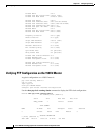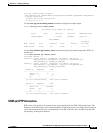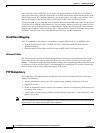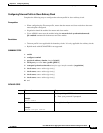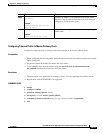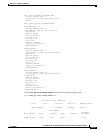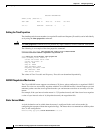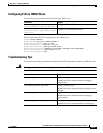
22-40
Cisco ASR 901 Series Aggregation Services Router Software Configuration Guide
OL-23826-09
Chapter 22 Configuring Clocking
Configuring PTP for the Cisco ASR 901 Router
If the T0 clock in Cisco ASR 901 is driven by the clock recovered from the OC Slave (if ToP0/12 is
selected as clock-source), then the clock quality in the PTP parent dataset represents the quality of the
ToP0/12 input clock. This should be informed to the netsync process for proper clock selection. This is
done by translating clockClass data field in clock quality to QL-values expected by netsync.
On the other hand, if Cisco ASR 901 serves as the OC Master, then the GM clock is the clock providing
T0 clock to Cisco ASR 901 router. Hence, the T0 clock quality should be used by OC master to fill up
clockClass in the clock quality field, in its default dataset. For this, the T0 output QL-value should be
mapped to the clockClass value according to ITU-T Telecom Profile, and set in the default dataset of the
OC Master. This QL-value is then transmitted to the PTP slaves and BC downstream.
ClockClass Mapping
The Cisco ASR 901 router supports two methods of mapping PTP ClockClass to SSM/QL-value:
• Telecom Profile based on ITU-T G.8265.1/Y.1365.1 PTP (Telecom) Profile for Frequency
Synchronization [2]
• Default method of calculating clockClass based on IEEE 1588v2 PTP specification.
Telecom Profiles
The Telecom Profile specifies an alternative algorithm for selecting between different master clocks,
based on the quality level (QL) of master clocks and on a local priority given to each master clock.
Release 3.11 introduces support for telecom profiles using a new configuration method, which allow you
to configure a clock to use the G.8265.1 recommendations for establishing PTP sessions, determining
the best master clock, handling SSM, and mapping PTP classes.
PTP Redundancy
PTP redundancy is an implementation on different clock nodes by which the PTP slave clock node
achieves the following:
• Interact with multiple master ports such as grand master, boundary clock nodes, and so on.
• Open PTP sessions.
• Select the best master from the existing list of masters (referred to as the primary PTP master port
or primary clock source).
• Switch to the next best master available in case the primary master fails, or the connectivity to the
primary master fails.
Note The Cisco ASR 901 Series Router supports unicast-based timing as specified in the 1588-2008 standard.
Hybrid mode is not supported with PTP 1588 redundancy.



